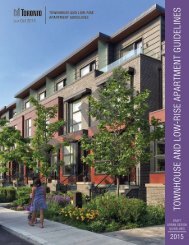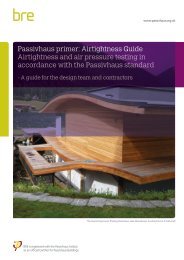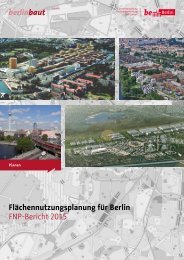TRUE URBAN SPIRIT
b008379b
b008379b
Create successful ePaper yourself
Turn your PDF publications into a flip-book with our unique Google optimized e-Paper software.
4 VIENNA: NETWORKING THE CITY<br />
AREA<br />
MANAGEMENT<br />
& MONITORING<br />
FOR EDUCATION<br />
INFRASTRUCTURE<br />
In coming years, reserving high-quality areas for educational<br />
facilities will be a central priority for the City of Vienna. For this<br />
reason, Vienna will on the one hand define frame conditions<br />
for infrastructure development by means of a time-tried instrument<br />
– the Infrastructure Commission – in newly created zones<br />
with subsidised housing. Moreover, criteria for privately financed<br />
housing construction are developed; clearcut priorities for land<br />
use in already built-up zones are set; uniform quality standards<br />
are laid down for the entire municipal territory (with regard to<br />
e. g. vacant plots, emission loads, public transport connections);<br />
and actual demand is constantly analysed and evaluated.<br />
FLAGSHIP INITIATIVE<br />
SPACE FOR EDUCATION<br />
To further improve the coherence of housing and<br />
infrastructure investments and in particular to reserve<br />
high-quality plots in time, Vienna will conduct accurate<br />
analyses of space demand for education infrastructure<br />
for the entire city as well as for individual urban<br />
quarters and will in addition extend its education monitoring<br />
activities. On this basis, spatial priorities will<br />
be defined and strategies for land mobilisation and<br />
reserves will be drafted while expansion potentials of<br />
existing locations will be explored.<br />
Application of the education monitoring system (Administrative<br />
Group for Urban Planning, Traffic & Transport,<br />
Climate Protection, Energy and Public Participation and<br />
Chief Administrative Office – Executive Group for Construction<br />
and Technology, Infrastructure Section), which inter alia<br />
prepares information regarding the following aspects:<br />
I annual comparison of predicted small-scale changes in<br />
population figures at the individual urban quarter level<br />
for children aged 0-14 years with actual developments;<br />
I comparison of foreseeable demand curves with agreed<br />
development plans.<br />
identification of spatial potentials of both already built<br />
and newly developed zones and possibilities of activating<br />
currently unused spaces.<br />
evaluation of possibilities for the intensified linkage of<br />
social infrastructure and other forms of use.<br />
132








